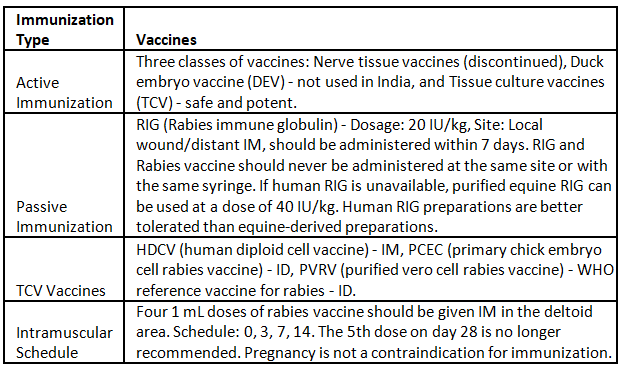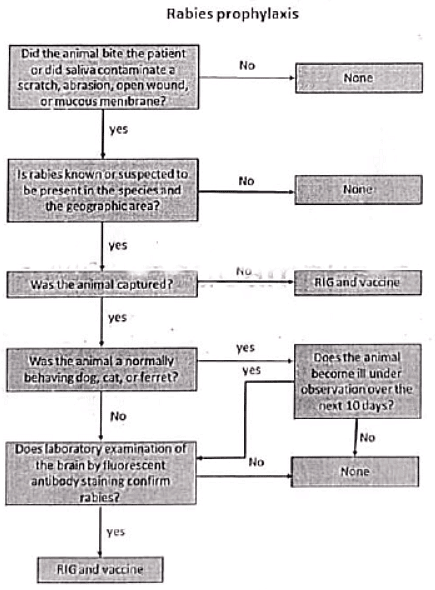Rabies | Medical Science Optional Notes for UPSC PDF Download
| Table of contents |

|
| Introduction |

|
| Rabies-Prevention |

|
| Intradermal vs Intramuscular Vaccination |

|
| Rabies-PEP management algorithm |

|
| National Rabies control program (NRCP) |

|
| Rabies-Repeats |

|

Introduction
- Controlling rabies in dogs is a straightforward process involving the vaccination of 70 percent of the entire dog population within a brief timeframe. It is crucial to sustain immune coverage and prevent the spread by regulating dog movements.
- Measures include the licensing of pet dogs, the capture and removal, if required, of stray and ownerless dogs, the use of muzzles on pet dogs, and mandatory immunization for all pet dogs.
Rabies-Prevention
Local treatment of the wound aims to eliminate as much virus as possible from the site of inoculation, particularly when administered immediately after exposure (within minutes).
- Cleansing: Swiftly wash the wound with an abundant amount of soap and water under a running tap.
- Chemical treatment: Following cleansing, deactivate the wound by irrigating it with virucidal agents such as tincture, iodine, or povidone iodine.
- Suturing: Avoid immediate suturing, as it may cause additional trauma and facilitate the virus's deeper penetration into tissues. If necessary, perform suturing 24-48 hours later.
- Antibiotics and Anti-tetanus serum: Consider the administration of antibiotics and anti-tetanus serum as part of the treatment protocol.


Intradermal vs Intramuscular Vaccination
The vaccination schedule using the two-site intradermal (ID) method is referred to as the Updated Thai Red Cross Schedule. In this regimen, a total of 0.2 ml of tissue culture rabies vaccine (ARV) is administered, with 0.1 ml on each deltoid area (or alternatively on the anterior aspect of both thighs). This approach involves the intradermal route, targeting two different lymphatic drainage sites. The vaccination is scheduled on days 0, 3, 7, and 28.
Advantages
- A reduced dosage is essential, requiring only a fraction of the intramuscular dose.
- This schedule is designed to save vaccines, promoting efficiency.
- It is cost-effective, resulting in economic benefits.
- A lower number of doses are needed, enhancing patient compliance and saving time, expenses, and clinic hours.
- The immune response is initiated promptly, leading to improved efficacy.
- There is minimal or no dilution in blood following dermal inoculation.
- It establishes a robust immune status, even in individuals with compromised health.
Contraindications
- Diabetes mellitus
- Hepatic insufficiency
- Malnutrition
- Antimalaria therapy
- Steroid or antiviral therapy and HIV infection
Rabies-PEP management algorithm

Rabies-Pre-exposure prophylaxis/prophylactic vaccination
- Individuals in high-risk groups, including dog catchers, veterinarians, and laboratory workers.
- Administration of three intramuscular doses (2.5 IU per dose) of tissue culture vaccine, given on days 0, 7, and 28 in the deltoid region.
- Periodic testing of antibody levels every 6 months.
- A booster dose is recommended whenever antibody titers fall below 0.5 IU/ml.
- Notably, even in cases of category III exposure, Rabies Immune Globulin (RIG) is not required, and only two doses of tissue culture vaccine (administered on day 0 and day 3) are necessary.
National Rabies control program (NRCP)
National Centre for Disease Control (formerly National Institute of Communicable Diseases), Delhi, WHO Collaborating Centre for Rabies Epidemiology, organized an expert consultation in 2002 to formulate national guidelines for rabies prophylaxis to bring out uniformity in postexposure prophylaxis practices. Due to new interventions in this field, it has been further revised over the years.
Under the 12th five-year plan, National Rabies Control Program (NRCP) has been approved. The NRCP has both human and animal health components.
Human Component
which is being implemented in all the states & UTs. National Centre for the Diseases control is the nodal agency for the Human Component of the program.
The strategies for the human component are:
- Training of health professionals
- Implementing use of intra-dermal route of inoculation of cell culture vaccines
- Strengthening surveillance of human rabies
- Information Education & Communication
- Laboratory strengthening
Animal Component
which is being pilot tested in the Haryana & Chennai. The Animal Welfare Board of India, Ministry of Environment & Forests is the Nodal agency for the Animal Component of the program.
The strategies for the animal component are:
- Population survey of dogs
- Mass vaccination of dogs
- Dog population management
Rabies-Repeats
Q1: Describe post-exposure prophylaxis (or rabies and management of dog bites. (2010)
Q2: A 7-year-old girl is brought with a history of dog-bite five minutes ago. She has abrasions on tier hand, but no bleeding. (2015)
(i) What category of bite would this injury fall under?
(ii) What are the first-aid measures which need to be given to this child?
(iii) What prophylactic steps would you take to prevent rabies in this child?
Q3: A 30-year old man has been bitten by a stray dog on his arm. How will you manage the case? (1996)
Q4: Management of class III dog bite in an adult. (1998)
Q5: Discuss the various methods for control of rabies in India. (2000)
Q6: Describe briefly the post-exposure prophylaxes of human rabies. (2007)
|
7 videos|219 docs
|
FAQs on Rabies - Medical Science Optional Notes for UPSC
| 1. What is the difference between intradermal and intramuscular vaccination for rabies prevention? |  |
| 2. Can you explain the rabies-PEP management algorithm? |  |
| 3. What is the National Rabies Control Program (NRCP)? |  |
| 4. When should rabies vaccination be repeated? |  |
| 5. How can I prevent rabies? |  |

|
Explore Courses for UPSC exam
|

|
















